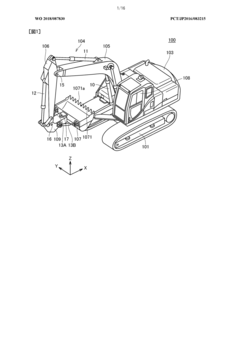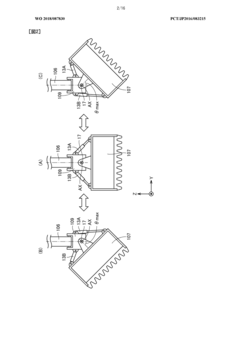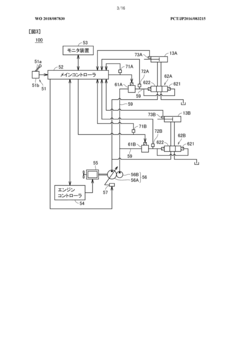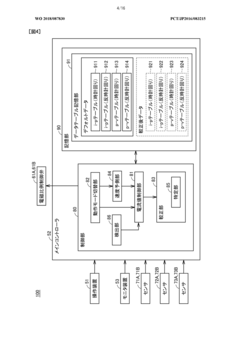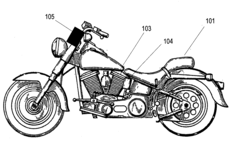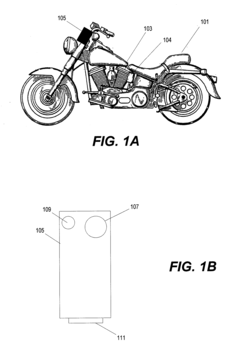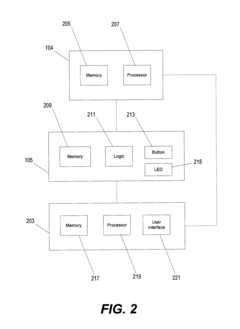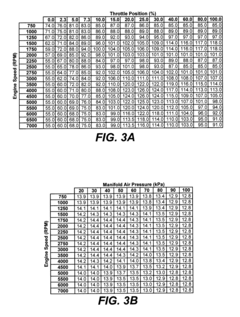K24 Engine Calibration: Achieving Precise Performance
JUL 3, 20259 MIN READ
Generate Your Research Report Instantly with AI Agent
Patsnap Eureka helps you evaluate technical feasibility & market potential.
K24 Engine Background
The K24 engine, developed by Honda Motor Company, has been a cornerstone of automotive engineering since its introduction in the early 2000s. This 2.4-liter inline-four cylinder engine has gained widespread recognition for its reliability, performance, and versatility across various Honda and Acura models. Initially designed to replace the F23 engine, the K24 has undergone several iterations and improvements over the years, cementing its position as a popular choice among car enthusiasts and manufacturers alike.
The K24 engine's development was driven by Honda's commitment to enhancing fuel efficiency, reducing emissions, and improving overall performance. Its design incorporates advanced technologies such as i-VTEC (intelligent Variable Valve Timing and Lift Electronic Control), which optimizes valve timing and lift for better power output and fuel economy across different engine speeds. This innovative approach has allowed the K24 to maintain its relevance in an increasingly competitive automotive landscape.
Throughout its evolution, the K24 engine has been featured in a diverse range of vehicles, from compact cars to SUVs and even light trucks. This widespread application has necessitated ongoing refinements and calibrations to meet the specific requirements of each vehicle type and market segment. The engine's adaptability has been a key factor in its longevity, with different variants tuned for various priorities such as fuel efficiency, low-end torque, or high-revving performance.
The quest for precise performance in K24 engine calibration has been driven by several factors, including stringent emissions regulations, increasing consumer demands for fuel efficiency, and the competitive nature of the automotive industry. As a result, engine calibration has become an increasingly complex and critical process, involving the fine-tuning of numerous parameters to achieve optimal performance, efficiency, and reliability.
In recent years, the focus on K24 engine calibration has shifted towards leveraging advanced technologies and methodologies. This includes the use of sophisticated engine management systems, real-time data analysis, and machine learning algorithms to optimize engine performance across a wide range of operating conditions. The goal is to achieve a delicate balance between power output, fuel consumption, emissions control, and drivability, all while ensuring the engine meets or exceeds regulatory standards.
The ongoing development and calibration of the K24 engine reflect the broader trends in the automotive industry towards more efficient, cleaner, and higher-performing powertrains. As the industry continues to evolve, with increasing emphasis on electrification and alternative fuels, the lessons learned from K24 engine calibration provide valuable insights for future powertrain development and optimization strategies.
The K24 engine's development was driven by Honda's commitment to enhancing fuel efficiency, reducing emissions, and improving overall performance. Its design incorporates advanced technologies such as i-VTEC (intelligent Variable Valve Timing and Lift Electronic Control), which optimizes valve timing and lift for better power output and fuel economy across different engine speeds. This innovative approach has allowed the K24 to maintain its relevance in an increasingly competitive automotive landscape.
Throughout its evolution, the K24 engine has been featured in a diverse range of vehicles, from compact cars to SUVs and even light trucks. This widespread application has necessitated ongoing refinements and calibrations to meet the specific requirements of each vehicle type and market segment. The engine's adaptability has been a key factor in its longevity, with different variants tuned for various priorities such as fuel efficiency, low-end torque, or high-revving performance.
The quest for precise performance in K24 engine calibration has been driven by several factors, including stringent emissions regulations, increasing consumer demands for fuel efficiency, and the competitive nature of the automotive industry. As a result, engine calibration has become an increasingly complex and critical process, involving the fine-tuning of numerous parameters to achieve optimal performance, efficiency, and reliability.
In recent years, the focus on K24 engine calibration has shifted towards leveraging advanced technologies and methodologies. This includes the use of sophisticated engine management systems, real-time data analysis, and machine learning algorithms to optimize engine performance across a wide range of operating conditions. The goal is to achieve a delicate balance between power output, fuel consumption, emissions control, and drivability, all while ensuring the engine meets or exceeds regulatory standards.
The ongoing development and calibration of the K24 engine reflect the broader trends in the automotive industry towards more efficient, cleaner, and higher-performing powertrains. As the industry continues to evolve, with increasing emphasis on electrification and alternative fuels, the lessons learned from K24 engine calibration provide valuable insights for future powertrain development and optimization strategies.
Market Demand Analysis
The market demand for K24 engine calibration solutions has been steadily increasing in recent years, driven by the automotive industry's push for improved performance, fuel efficiency, and emissions control. As vehicle manufacturers strive to meet stringent regulatory requirements while delivering enhanced driving experiences, the need for precise engine calibration has become paramount.
The global automotive engine management system market, which includes engine calibration technologies, is projected to grow significantly. This growth is fueled by the rising production of vehicles worldwide, particularly in emerging economies, and the increasing adoption of advanced engine technologies. The demand for K24 engine calibration is particularly strong in the performance and luxury vehicle segments, where consumers expect optimal power delivery and responsiveness.
Environmental concerns and government regulations play a crucial role in shaping market demand. Stricter emissions standards, such as Euro 6 in Europe and Tier 3 in the United States, have compelled automakers to invest heavily in engine calibration technologies that can achieve both performance targets and emissions compliance. This regulatory pressure has created a substantial market for advanced calibration tools and expertise.
The aftermarket sector also contributes significantly to the demand for K24 engine calibration. Performance enthusiasts and tuning shops seek customizable solutions to extract maximum power and efficiency from their engines. This has led to a growing market for aftermarket ECU tuning software and hardware that can fine-tune K24 engines for various applications, from daily driving to motorsports.
In the commercial vehicle sector, fleet operators are increasingly recognizing the benefits of precise engine calibration. Improved fuel economy and reduced maintenance costs are driving the adoption of advanced calibration techniques for K24 engines used in light commercial vehicles and some medium-duty trucks.
The integration of artificial intelligence and machine learning in engine calibration processes is emerging as a key trend. These technologies promise to streamline the calibration process, reduce development time, and achieve more optimal results. As a result, there is a growing demand for calibration solutions that incorporate AI-driven algorithms and data analytics capabilities.
The market for K24 engine calibration is also influenced by the broader trend towards vehicle electrification. While this shift poses a long-term challenge to traditional combustion engine technologies, it has paradoxically increased the short-term demand for advanced calibration solutions. Automakers are investing in improving the efficiency of their existing engine lineups, including the K24, as a bridge technology while electric vehicle infrastructure and technology continue to develop.
The global automotive engine management system market, which includes engine calibration technologies, is projected to grow significantly. This growth is fueled by the rising production of vehicles worldwide, particularly in emerging economies, and the increasing adoption of advanced engine technologies. The demand for K24 engine calibration is particularly strong in the performance and luxury vehicle segments, where consumers expect optimal power delivery and responsiveness.
Environmental concerns and government regulations play a crucial role in shaping market demand. Stricter emissions standards, such as Euro 6 in Europe and Tier 3 in the United States, have compelled automakers to invest heavily in engine calibration technologies that can achieve both performance targets and emissions compliance. This regulatory pressure has created a substantial market for advanced calibration tools and expertise.
The aftermarket sector also contributes significantly to the demand for K24 engine calibration. Performance enthusiasts and tuning shops seek customizable solutions to extract maximum power and efficiency from their engines. This has led to a growing market for aftermarket ECU tuning software and hardware that can fine-tune K24 engines for various applications, from daily driving to motorsports.
In the commercial vehicle sector, fleet operators are increasingly recognizing the benefits of precise engine calibration. Improved fuel economy and reduced maintenance costs are driving the adoption of advanced calibration techniques for K24 engines used in light commercial vehicles and some medium-duty trucks.
The integration of artificial intelligence and machine learning in engine calibration processes is emerging as a key trend. These technologies promise to streamline the calibration process, reduce development time, and achieve more optimal results. As a result, there is a growing demand for calibration solutions that incorporate AI-driven algorithms and data analytics capabilities.
The market for K24 engine calibration is also influenced by the broader trend towards vehicle electrification. While this shift poses a long-term challenge to traditional combustion engine technologies, it has paradoxically increased the short-term demand for advanced calibration solutions. Automakers are investing in improving the efficiency of their existing engine lineups, including the K24, as a bridge technology while electric vehicle infrastructure and technology continue to develop.
Technical Challenges
The K24 engine calibration process faces several significant technical challenges in achieving precise performance. One of the primary obstacles is the complexity of modern engine management systems, which involve numerous interconnected parameters that must be finely tuned to optimize performance, fuel efficiency, and emissions.
The calibration process requires extensive testing and data analysis to determine the optimal settings for various engine operating conditions. This includes mapping fuel injection timing, ignition timing, valve timing, and air-fuel ratios across a wide range of engine speeds and loads. The sheer volume of data points and the intricate relationships between these parameters make the calibration process time-consuming and resource-intensive.
Another major challenge is the need to balance conflicting performance objectives. For instance, maximizing power output may come at the expense of fuel efficiency or increased emissions. Calibrators must navigate these trade-offs to find the optimal balance that meets regulatory requirements while delivering the desired performance characteristics.
The variability in manufacturing tolerances and component wear over time also presents a significant challenge. Calibrations must be robust enough to accommodate these variations without compromising engine performance or reliability. This requires sophisticated adaptive strategies and real-time adjustments to maintain optimal performance throughout the engine's lifecycle.
Environmental factors such as altitude, temperature, and humidity can significantly impact engine performance. Developing calibrations that can adapt to these changing conditions while maintaining consistent performance is a complex task that requires advanced sensing and control algorithms.
The increasing stringency of emissions regulations poses another substantial challenge. Calibrators must develop strategies to minimize pollutants such as NOx, CO, and particulate matter without sacrificing performance or drivability. This often involves sophisticated aftertreatment systems and precise control of combustion processes.
Lastly, the integration of new technologies such as variable valve timing, direct injection, and turbocharging adds layers of complexity to the calibration process. These advanced systems offer greater potential for performance optimization but also introduce additional variables that must be carefully managed to achieve the desired results.
The calibration process requires extensive testing and data analysis to determine the optimal settings for various engine operating conditions. This includes mapping fuel injection timing, ignition timing, valve timing, and air-fuel ratios across a wide range of engine speeds and loads. The sheer volume of data points and the intricate relationships between these parameters make the calibration process time-consuming and resource-intensive.
Another major challenge is the need to balance conflicting performance objectives. For instance, maximizing power output may come at the expense of fuel efficiency or increased emissions. Calibrators must navigate these trade-offs to find the optimal balance that meets regulatory requirements while delivering the desired performance characteristics.
The variability in manufacturing tolerances and component wear over time also presents a significant challenge. Calibrations must be robust enough to accommodate these variations without compromising engine performance or reliability. This requires sophisticated adaptive strategies and real-time adjustments to maintain optimal performance throughout the engine's lifecycle.
Environmental factors such as altitude, temperature, and humidity can significantly impact engine performance. Developing calibrations that can adapt to these changing conditions while maintaining consistent performance is a complex task that requires advanced sensing and control algorithms.
The increasing stringency of emissions regulations poses another substantial challenge. Calibrators must develop strategies to minimize pollutants such as NOx, CO, and particulate matter without sacrificing performance or drivability. This often involves sophisticated aftertreatment systems and precise control of combustion processes.
Lastly, the integration of new technologies such as variable valve timing, direct injection, and turbocharging adds layers of complexity to the calibration process. These advanced systems offer greater potential for performance optimization but also introduce additional variables that must be carefully managed to achieve the desired results.
Current Calibration Methods
01 Engine control and optimization
Advanced control systems and algorithms are used to optimize the K24 engine's performance. These systems monitor various parameters such as fuel injection, ignition timing, and valve timing to enhance power output, fuel efficiency, and emissions control. The engine control unit (ECU) plays a crucial role in managing these functions and adapting to different driving conditions.- Engine control and optimization: Advanced control systems and algorithms are used to optimize the K24 engine's performance. These systems monitor various parameters such as fuel injection, ignition timing, and valve timing to enhance power output, fuel efficiency, and emissions control. Real-time adjustments are made based on driving conditions and engine load to ensure optimal performance across different scenarios.
- Turbocharging and forced induction: Turbocharging technology is applied to the K24 engine to increase power output and improve overall performance. This involves using exhaust gases to drive a turbine, which in turn compresses the intake air, allowing more air and fuel to be forced into the combustion chamber. The result is increased horsepower and torque across a wider range of engine speeds.
- Variable valve timing and lift: The K24 engine incorporates variable valve timing and lift systems to optimize performance across different engine speeds and loads. These systems allow for precise control of valve opening and closing times, as well as the amount of valve lift, resulting in improved power output, fuel efficiency, and reduced emissions throughout the engine's operating range.
- Fuel injection and combustion optimization: Advanced fuel injection systems and combustion chamber designs are employed to enhance the K24 engine's performance. Direct injection technology, coupled with optimized injector placement and spray patterns, ensures precise fuel delivery and improved atomization. This leads to more efficient combustion, increased power output, and reduced fuel consumption.
- Engine cooling and thermal management: Efficient cooling systems and thermal management strategies are implemented to maintain optimal operating temperatures for the K24 engine. This includes advanced radiator designs, precision-controlled coolant flow, and intelligent fan control systems. By effectively managing heat dissipation, the engine can operate at peak performance levels while preventing overheating and reducing wear on components.
02 Turbocharging and forced induction
Turbocharging technology is applied to the K24 engine to increase its power output and overall performance. This involves using exhaust gases to drive a turbine, which in turn compresses the intake air, allowing for more efficient combustion. Various designs and configurations of turbochargers are employed to achieve optimal boost pressure and minimize turbo lag.Expand Specific Solutions03 Variable valve timing and lift
The K24 engine incorporates variable valve timing and lift mechanisms to improve performance across different engine speeds and load conditions. These systems allow for precise control of valve opening and closing times, as well as the amount of valve lift, resulting in enhanced power output, fuel efficiency, and reduced emissions.Expand Specific Solutions04 Fuel injection and combustion optimization
Advanced fuel injection systems are utilized in the K24 engine to optimize combustion efficiency. Direct injection technology, coupled with precise fuel metering and spray patterns, ensures better fuel atomization and mixing with air. This leads to improved power output, fuel economy, and reduced emissions across various operating conditions.Expand Specific Solutions05 Engine diagnostics and performance monitoring
Sophisticated diagnostic systems are integrated into the K24 engine to monitor its performance and detect potential issues. These systems use various sensors and data analysis techniques to provide real-time feedback on engine health, emissions, and efficiency. This allows for proactive maintenance and optimization of engine performance over time.Expand Specific Solutions
Key Industry Players
The K24 Engine Calibration market is in a mature stage, with established players like Continental Automotive, Robert Bosch, and DENSO leading the field. The market size is substantial, driven by the automotive industry's continuous demand for precise engine performance. Technologically, the field is advanced, with companies like Mazda, Toyota, and Honda pushing boundaries in engine efficiency and performance. Weichai Power and AVL List are making significant strides in powertrain development, while Siemens and Schaeffler contribute advanced automotive technologies. Universities like Hebei University of Technology are fostering innovation through research. The competitive landscape is intense, with both traditional automakers and specialized engineering firms vying for market share in this critical automotive technology sector.
Robert Bosch GmbH
Technical Solution: Bosch's K24 engine calibration approach focuses on precise performance through advanced model-based calibration techniques. They utilize a combination of hardware-in-the-loop (HIL) simulation and machine learning algorithms to optimize engine parameters. Their system employs real-time data acquisition and analysis, allowing for dynamic adjustments to fuel injection timing, valve timing, and ignition timing[1]. Bosch's calibration process incorporates a multi-objective optimization framework that balances performance, fuel efficiency, and emissions compliance[3]. The company has developed proprietary software tools that enable rapid prototyping and validation of calibration strategies, significantly reducing development time[5].
Strengths: Comprehensive approach integrating advanced simulation and AI techniques; Rapid prototyping capabilities. Weaknesses: Potentially high implementation costs; Requires extensive expertise to fully utilize the system.
DENSO Corp.
Technical Solution: DENSO's K24 engine calibration strategy emphasizes high-precision control through their advanced Engine Control Unit (ECU) technology. Their approach incorporates model-predictive control algorithms that anticipate and adjust for varying driving conditions in real-time[2]. DENSO utilizes a sophisticated sensor network to gather comprehensive engine data, including temperature, pressure, and exhaust composition. This data feeds into their proprietary calibration software, which employs neural networks to continuously refine engine parameters[4]. The company has also developed a unique cylinder-by-cylinder calibration technique, allowing for more granular control over combustion processes and emissions reduction[6].
Strengths: High-precision control with advanced ECU technology; Innovative cylinder-by-cylinder calibration. Weaknesses: May require more complex hardware setup; Potential for increased computational demands on the ECU.
Advanced Calibration Tech
Work vehicle and data calibration method
PatentWO2018087830A1
Innovation
- A work vehicle configuration that includes an operating device, a valve for hydraulic oil flow rate adjustment, an electromagnetic proportional control valve, and a controller with a storage unit and calibration unit, which calibrates data on the condition of operator input, ensuring accurate reflection of operator intentions through precise calibration of command pilot pressure and current relationships.
Vehicle calibration using data collected during normal operating conditions
PatentInactiveUS20120259533A1
Innovation
- A portable vehicle communication interface module records adjustments made by the engine control unit during normal operation, allowing for the creation of updated calibration tables that optimize volumetric efficiency based on actual real-world data, enabling adjustments to fuel injection and air-fuel ratios.
Emissions Regulations
Emissions regulations play a crucial role in shaping the development and calibration of modern engines, including the K24 engine. These regulations are designed to limit the environmental impact of vehicle emissions and have become increasingly stringent over the years. For the K24 engine calibration process, achieving precise performance while meeting emissions standards is a significant challenge.
The primary focus of emissions regulations is on reducing harmful pollutants such as carbon monoxide (CO), nitrogen oxides (NOx), hydrocarbons (HC), and particulate matter (PM). These regulations vary by region, with some of the most stringent standards being set by the European Union (Euro standards) and the United States Environmental Protection Agency (EPA).
To comply with these regulations, engine calibrators must optimize various parameters, including fuel injection timing, air-fuel ratio, exhaust gas recirculation (EGR), and catalytic converter performance. The K24 engine, being a relatively modern design, incorporates advanced technologies to help meet these standards while maintaining performance.
One of the key strategies employed in K24 engine calibration is the use of closed-loop feedback systems. These systems continuously monitor exhaust gases and adjust engine parameters in real-time to maintain optimal emissions levels. This approach allows for more precise control over the combustion process and helps to minimize the production of harmful pollutants.
Another important aspect of emissions compliance is the integration of aftertreatment systems. For the K24 engine, this typically includes a three-way catalytic converter, which is highly effective at reducing CO, NOx, and HC emissions. The calibration process must ensure that the engine operates within the catalyst's optimal temperature range and that the air-fuel ratio is precisely controlled to maximize the converter's efficiency.
The challenge for calibrators lies in balancing emissions compliance with performance and fuel efficiency. Stricter emissions standards often require compromises in other areas, such as power output or fuel consumption. However, advanced calibration techniques and technologies have allowed engineers to minimize these trade-offs, resulting in engines that are both clean and powerful.
As emissions regulations continue to evolve, the K24 engine calibration process must adapt accordingly. This may involve the implementation of new technologies, such as gasoline particulate filters or more advanced EGR systems. Calibrators must stay informed about upcoming regulatory changes and anticipate future requirements to ensure that the K24 engine remains compliant and competitive in the market.
The primary focus of emissions regulations is on reducing harmful pollutants such as carbon monoxide (CO), nitrogen oxides (NOx), hydrocarbons (HC), and particulate matter (PM). These regulations vary by region, with some of the most stringent standards being set by the European Union (Euro standards) and the United States Environmental Protection Agency (EPA).
To comply with these regulations, engine calibrators must optimize various parameters, including fuel injection timing, air-fuel ratio, exhaust gas recirculation (EGR), and catalytic converter performance. The K24 engine, being a relatively modern design, incorporates advanced technologies to help meet these standards while maintaining performance.
One of the key strategies employed in K24 engine calibration is the use of closed-loop feedback systems. These systems continuously monitor exhaust gases and adjust engine parameters in real-time to maintain optimal emissions levels. This approach allows for more precise control over the combustion process and helps to minimize the production of harmful pollutants.
Another important aspect of emissions compliance is the integration of aftertreatment systems. For the K24 engine, this typically includes a three-way catalytic converter, which is highly effective at reducing CO, NOx, and HC emissions. The calibration process must ensure that the engine operates within the catalyst's optimal temperature range and that the air-fuel ratio is precisely controlled to maximize the converter's efficiency.
The challenge for calibrators lies in balancing emissions compliance with performance and fuel efficiency. Stricter emissions standards often require compromises in other areas, such as power output or fuel consumption. However, advanced calibration techniques and technologies have allowed engineers to minimize these trade-offs, resulting in engines that are both clean and powerful.
As emissions regulations continue to evolve, the K24 engine calibration process must adapt accordingly. This may involve the implementation of new technologies, such as gasoline particulate filters or more advanced EGR systems. Calibrators must stay informed about upcoming regulatory changes and anticipate future requirements to ensure that the K24 engine remains compliant and competitive in the market.
Performance Benchmarking
Performance benchmarking is a critical aspect of K24 engine calibration, providing essential data for achieving precise performance. This process involves systematic testing and comparison of the engine's performance metrics against established standards or competitor models. The benchmarking process typically begins with identifying key performance indicators (KPIs) relevant to the K24 engine, such as horsepower, torque, fuel efficiency, emissions, and throttle response.
To ensure accurate and comprehensive benchmarking, a standardized testing protocol is established. This protocol outlines specific test conditions, including ambient temperature, humidity, fuel quality, and engine load scenarios. Dynamometer testing is a fundamental component of performance benchmarking, allowing for controlled measurement of power output and torque curves across various engine speeds and loads.
In addition to power and torque, fuel consumption is a crucial metric in performance benchmarking. Standardized drive cycles, such as the New European Driving Cycle (NEDC) or the Worldwide Harmonized Light Vehicles Test Procedure (WLTP), are employed to assess fuel efficiency under different driving conditions. These tests provide valuable insights into the engine's real-world performance and efficiency.
Emissions testing is another vital aspect of performance benchmarking, particularly given increasingly stringent environmental regulations. The K24 engine's emissions are measured across various operating conditions, focusing on key pollutants such as carbon monoxide, nitrogen oxides, and particulate matter. This data is crucial for ensuring compliance with emissions standards and identifying areas for improvement in the engine's environmental performance.
Throttle response and driveability are subjective yet essential aspects of engine performance. Benchmarking in this area involves both quantitative measurements, such as throttle response time, and qualitative assessments by experienced test drivers. These evaluations provide insights into the engine's responsiveness and overall driving experience, which are critical factors in consumer satisfaction.
Comparative analysis forms a significant part of the benchmarking process. The K24 engine's performance metrics are compared against previous iterations of the engine, as well as similar engines from competitors. This comparison helps identify areas where the K24 excels and areas that may require further optimization. Advanced data analysis techniques, including statistical modeling and trend analysis, are employed to extract meaningful insights from the benchmarking data.
The results of performance benchmarking serve as a foundation for the calibration process, guiding engineers in fine-tuning various engine parameters to achieve optimal performance. This data-driven approach ensures that the calibration efforts are focused on areas with the greatest potential for improvement, ultimately leading to a more precisely tuned and high-performing K24 engine.
To ensure accurate and comprehensive benchmarking, a standardized testing protocol is established. This protocol outlines specific test conditions, including ambient temperature, humidity, fuel quality, and engine load scenarios. Dynamometer testing is a fundamental component of performance benchmarking, allowing for controlled measurement of power output and torque curves across various engine speeds and loads.
In addition to power and torque, fuel consumption is a crucial metric in performance benchmarking. Standardized drive cycles, such as the New European Driving Cycle (NEDC) or the Worldwide Harmonized Light Vehicles Test Procedure (WLTP), are employed to assess fuel efficiency under different driving conditions. These tests provide valuable insights into the engine's real-world performance and efficiency.
Emissions testing is another vital aspect of performance benchmarking, particularly given increasingly stringent environmental regulations. The K24 engine's emissions are measured across various operating conditions, focusing on key pollutants such as carbon monoxide, nitrogen oxides, and particulate matter. This data is crucial for ensuring compliance with emissions standards and identifying areas for improvement in the engine's environmental performance.
Throttle response and driveability are subjective yet essential aspects of engine performance. Benchmarking in this area involves both quantitative measurements, such as throttle response time, and qualitative assessments by experienced test drivers. These evaluations provide insights into the engine's responsiveness and overall driving experience, which are critical factors in consumer satisfaction.
Comparative analysis forms a significant part of the benchmarking process. The K24 engine's performance metrics are compared against previous iterations of the engine, as well as similar engines from competitors. This comparison helps identify areas where the K24 excels and areas that may require further optimization. Advanced data analysis techniques, including statistical modeling and trend analysis, are employed to extract meaningful insights from the benchmarking data.
The results of performance benchmarking serve as a foundation for the calibration process, guiding engineers in fine-tuning various engine parameters to achieve optimal performance. This data-driven approach ensures that the calibration efforts are focused on areas with the greatest potential for improvement, ultimately leading to a more precisely tuned and high-performing K24 engine.
Unlock deeper insights with Patsnap Eureka Quick Research — get a full tech report to explore trends and direct your research. Try now!
Generate Your Research Report Instantly with AI Agent
Supercharge your innovation with Patsnap Eureka AI Agent Platform!
